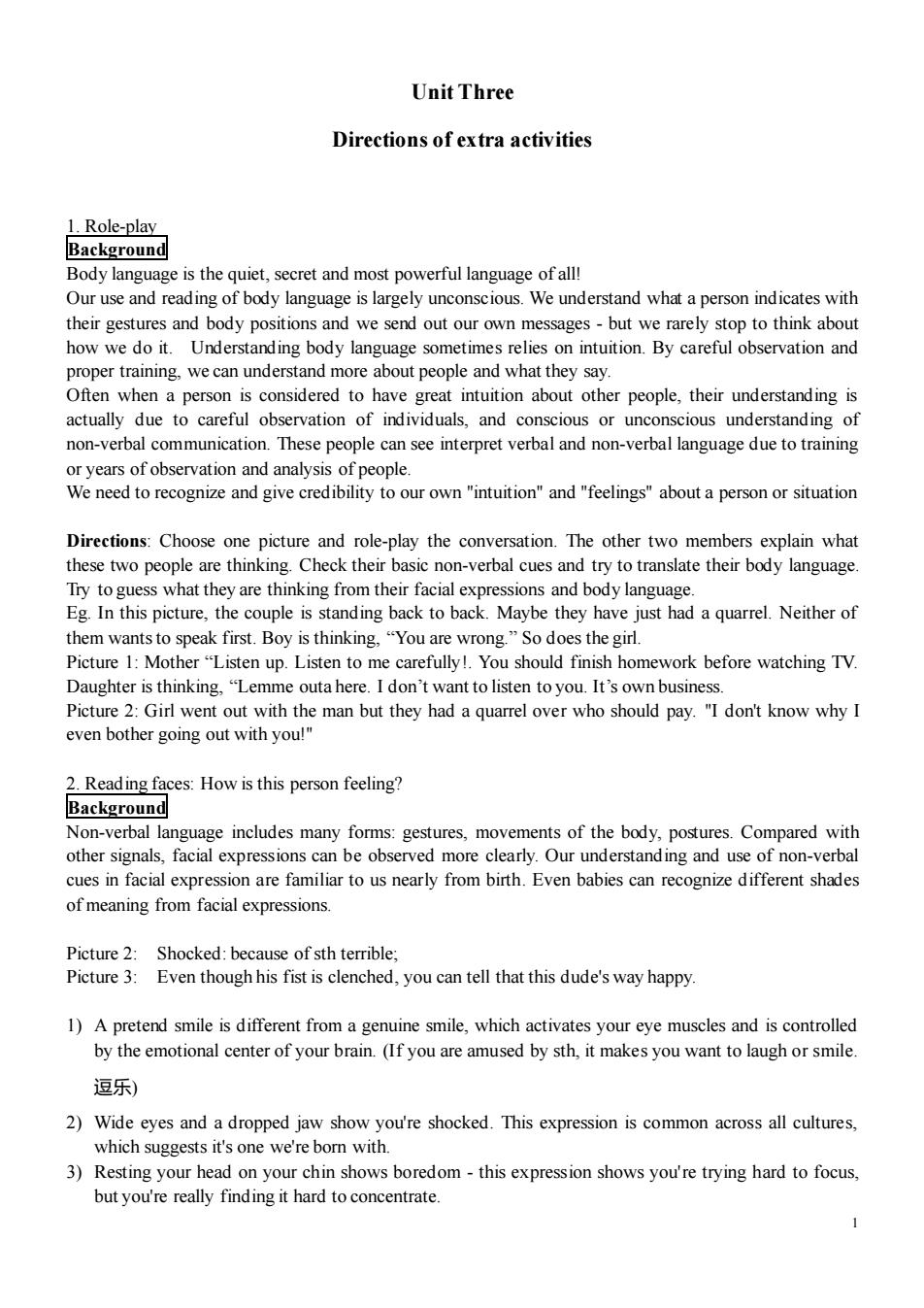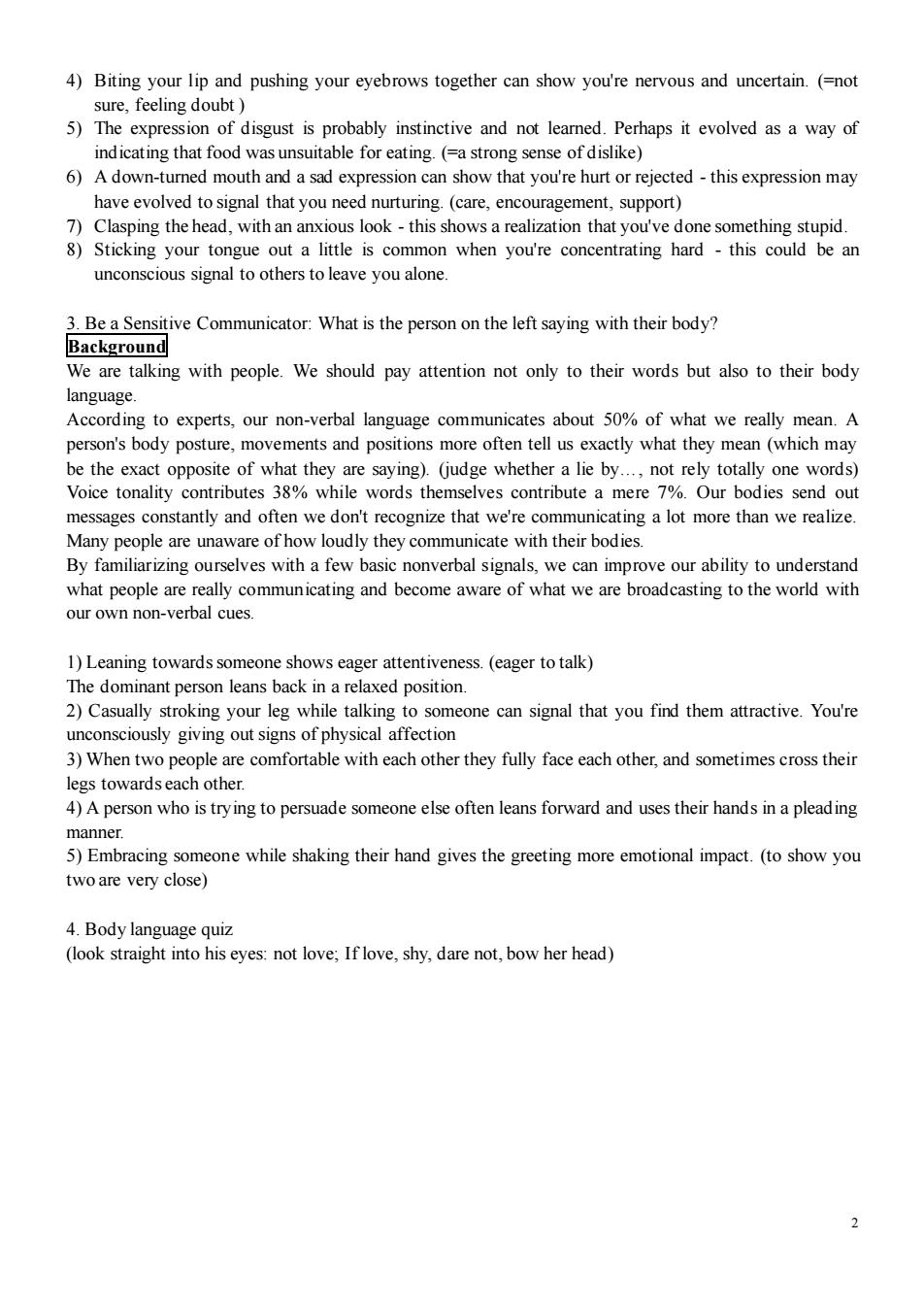
Unit Three Directions of extra activities 1.Role-play Background Body language is the quiet,secret and most powerful language of all! Our use and reading of body language is largely unconscious.We understand what a person indicates with their gestures and body positions and we send out our own messages-but we rarely stop to think about how we do it.Understanding body language sometimes relies on intuition.By careful observation and proper training,we can understand more about people and what they say. Often when a person is considered to have great intuition about other people,their understanding is actually due to careful observation of individuals,and conscious or unconscious understanding of non-verbal communication.These people can see interpret verbal and non-verbal language due to training or years of observation and analysis of people. We need to recognize and give credibility to our own "intuition"and "feelings"about a person or situation Directions:Choose one picture and role-play the conversation.The other two members explain what these two people are thinking.Check their basic non-verbal cues and try to translate their body language. Try to guess what they are thinking from their facial expressions and body language. Eg.In this picture,the couple is standing back to back.Maybe they have just had a quarrel.Neither of them wants to speak first.Boy is thinking,"You are wrong."So does the girl. Picture 1:Mother "Listen up.Listen to me carefully!.You should finish homework before watching TV. Daughter is thinking,"Lemme outa here.I don't want to listen to you.It's own business. Picture 2:Girl went out with the man but they had a quarrel over who should pay."I don't know why I even bother going out with you!" 2.Reading faces:How is this person feeling? Background Non-verbal language includes many forms:gestures,movements of the body,postures.Compared with other signals,facial expressions can be observed more clearly.Our understand ing and use of non-verbal cues in facial expression are familiar to us nearly from birth.Even babies can recognize different shades of meaning from facial expressions. Picture 2:Shocked:because of sth terrible; Picture 3:Even though his fist is clenched,you can tell that this dude's way happy. 1)A pretend smile is different from a genuine smile,which activates your eye muscles and is controlled by the emotional center of your brain.(If you are amused by sth,it makes you want to laugh or smile. 逗乐) 2)Wide eyes and a dropped jaw show you're shocked.This expression is common across all cultures, which suggests it's one we're born with. 3)Resting your head on your chin shows boredom-this expression shows you're trying hard to focus, but you're really finding it hard to concentrate
1 Unit Three Directions of extra activities 1. Role-play Background Body language is the quiet, secret and most powerful language of all! Our use and reading of body language is largely unconscious. We understand what a person indicates with their gestures and body positions and we send out our own messages - but we rarely stop to think about how we do it. Understanding body language sometimes relies on intuition. By careful observation and proper training, we can understand more about people and what they say. Often when a person is considered to have great intuition about other people, their understanding is actually due to careful observation of individuals, and conscious or unconscious understanding of non-verbal communication. These people can see interpret verbal and non-verbal language due to training or years of observation and analysis of people. We need to recognize and give credibility to our own "intuition" and "feelings" about a person or situation Directions: Choose one picture and role-play the conversation. The other two members explain what these two people are thinking. Check their basic non-verbal cues and try to translate their body language. Try to guess what they are thinking from their facial expressions and body language. Eg. In this picture, the couple is standing back to back. Maybe they have just had a quarrel. Neither of them wants to speak first. Boy is thinking, “You are wrong.” So does the girl. Picture 1: Mother “Listen up. Listen to me carefully!. You should finish homework before watching TV. Daughter is thinking, “Lemme outa here. I don’t want to listen to you. It’s own business. Picture 2: Girl went out with the man but they had a quarrel over who should pay. "I don't know why I even bother going out with you!" 2. Reading faces: How is this person feeling? Background Non-verbal language includes many forms: gestures, movements of the body, postures. Compared with other signals, facial expressions can be observed more clearly. Our understanding and use of non-verbal cues in facial expression are familiar to us nearly from birth. Even babies can recognize different shades of meaning from facial expressions. Picture 2: Shocked: because of sth terrible; Picture 3: Even though his fist is clenched, you can tell that this dude's way happy. 1) A pretend smile is different from a genuine smile, which activates your eye muscles and is controlled by the emotional center of your brain. (If you are amused by sth, it makes you want to laugh or smile. 逗乐) 2) Wide eyes and a dropped jaw show you're shocked. This expression is common across all cultures, which suggests it's one we're born with. 3) Resting your head on your chin shows boredom - this expression shows you're trying hard to focus, but you're really finding it hard to concentrate

4)Biting your lip and pushing your eyebrows together can show you're nervous and uncertain.(=not sure,feeling doubt 5)The expression of disgust is probably instinctive and not learned.Perhaps it evolved as a way of ind icating that food was unsuitable for eating.(=a strong sense of dislike) 6)A down-turned mouth and a sad expression can show that you're hurt or rejected-this expression may have evolved to signal that you need nurturing.(care,encouragement,support) 7)Clasping the head,with an anxious look-this shows a realization that you've done something stupid. 8)Sticking your tongue out a little is common when you're concentrating hard -this could be an unconscious signal to others to leave you alone. 3.Be a Sensitive Communicator:What is the person on the left saying with their body? Background We are talking with people.We should pay attention not only to their words but also to their body language. According to experts,our non-verbal language communicates about 50%of what we really mean.A person's body posture,movements and positions more often tell us exactly what they mean (which may be the exact opposite of what they are saying).(judge whether a lie by...,not rely totally one words) Voice tonality contributes 38%while words themselves contribute a mere 7%.Our bodies send out messages constantly and often we don't recognize that we're communicating a lot more than we realize. Many people are unaware of how loudly they communicate with their bodies. By familiarizing ourselves with a few basic nonverbal signals,we can improve our ability to understand what people are really communicating and become aware of what we are broadcasting to the world with our own non-verbal cues. 1)Leaning towards someone shows eager attentiveness.(eager to talk) The dominant person leans back in a relaxed position. 2)Casually stroking your leg while talking to someone can signal that you find them attractive.You're unconsciously giving out signs of physical affection 3)When two people are comfortable with each other they fully face each other,and sometimes cross their legs towards each other. 4)A person who is trying to persuade someone else often leans forward and uses their hands in a plead ing manner. 5)Embracing someone while shaking their hand gives the greeting more emotional impact.(to show you two are very close) 4.Body language quiz (look straight into his eyes:not love;If love,shy,dare not,bow her head)
2 4) Biting your lip and pushing your eyebrows together can show you're nervous and uncertain. (=not sure, feeling doubt ) 5) The expression of disgust is probably instinctive and not learned. Perhaps it evolved as a way of indicating that food was unsuitable for eating. (=a strong sense of dislike) 6) A down-turned mouth and a sad expression can show that you're hurt or rejected - this expression may have evolved to signal that you need nurturing. (care, encouragement, support) 7) Clasping the head, with an anxious look - this shows a realization that you've done something stupid. 8) Sticking your tongue out a little is common when you're concentrating hard - this could be an unconscious signal to others to leave you alone. 3. Be a Sensitive Communicator: What is the person on the left saying with their body? Background We are talking with people. We should pay attention not only to their words but also to their body language. According to experts, our non-verbal language communicates about 50% of what we really mean. A person's body posture, movements and positions more often tell us exactly what they mean (which may be the exact opposite of what they are saying). (judge whether a lie by…, not rely totally one words) Voice tonality contributes 38% while words themselves contribute a mere 7%. Our bodies send out messages constantly and often we don't recognize that we're communicating a lot more than we realize. Many people are unaware of how loudly they communicate with their bodies. By familiarizing ourselves with a few basic nonverbal signals, we can improve our ability to understand what people are really communicating and become aware of what we are broadcasting to the world with our own non-verbal cues. 1) Leaning towards someone shows eager attentiveness. (eager to talk) The dominant person leans back in a relaxed position. 2) Casually stroking your leg while talking to someone can signal that you find them attractive. You're unconsciously giving out signs of physical affection 3) When two people are comfortable with each other they fully face each other, and sometimes cross their legs towards each other. 4) A person who is trying to persuade someone else often leans forward and uses their hands in a pleading manner. 5) Embracing someone while shaking their hand gives the greeting more emotional impact. (to show you two are very close) 4. Body language quiz (look straight into his eyes: not love; If love, shy, dare not, bow her head)